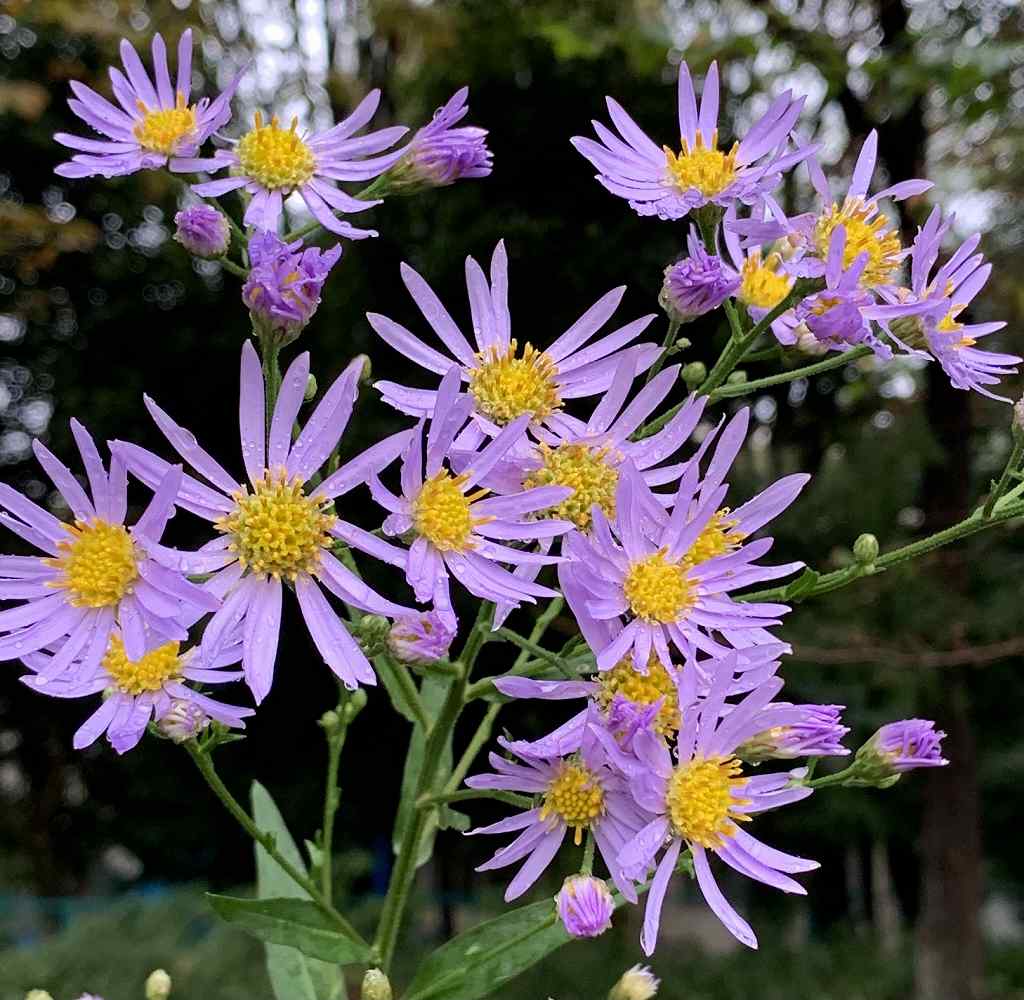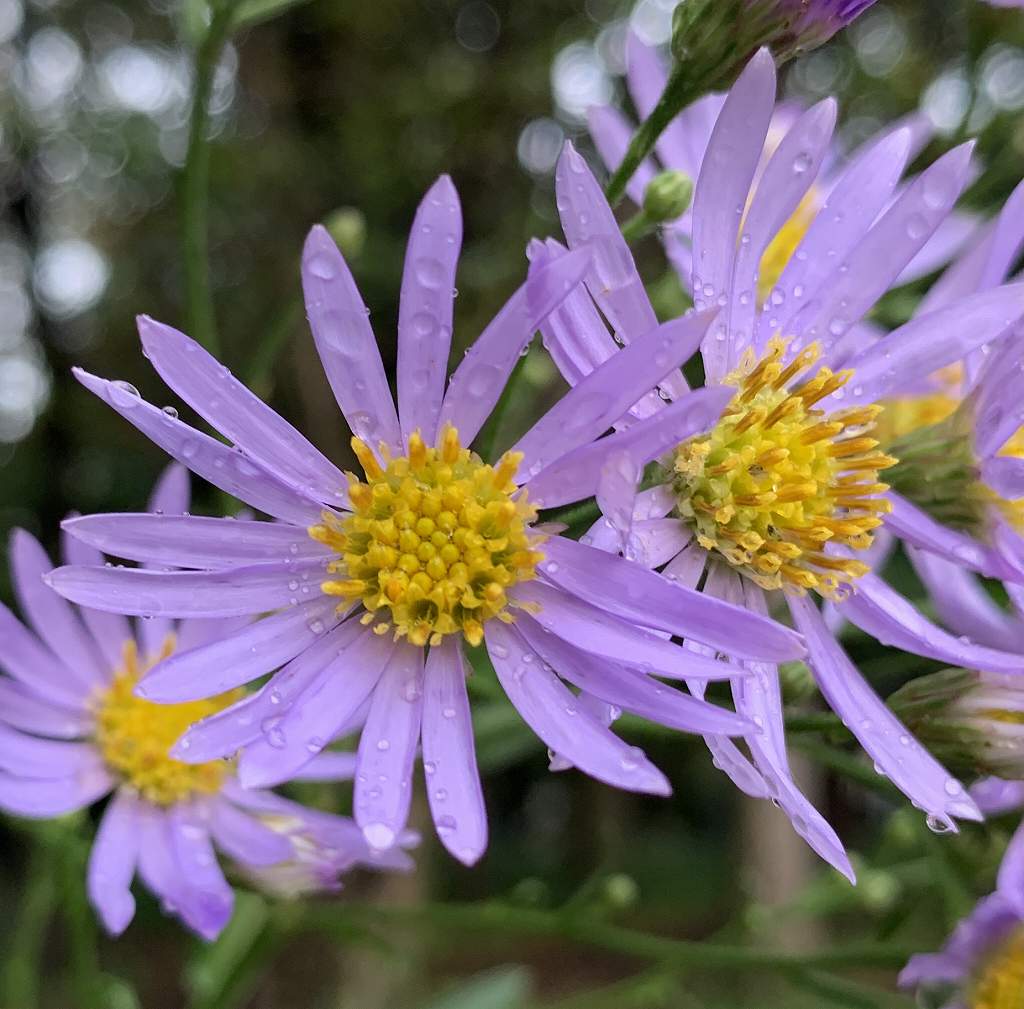シオンの花は、周りが薄紫色の舌状花、真ん中が黄色の筒状花。根や根茎にはサポニン類が含まれ、身体を温める薬草として知られています。
Tatarian aster flowers are lilac tongue-shaped flowers around and yellow tubular flowers in the middle. The roots and rhizomes contain saponins and are known as herbs that warm the body.
【仮名】シオン, オニノシコグサ, ジュウゴヤソウ, オモイグサ
【和名】紫苑, 鬼の醜草, 十五夜草, 思い草
【英名】Tatarian Aster
【学名】Aster tataricus
【誕生】09/ 09, 09/ 28, 10/ 03, 10/ 16
【開花】08, 09, 10月
【花色】Violet


シオン
シオンの生態
シオンはキク科シオン属の多年草です。原産地は中国北部、朝鮮半島、シベリア。日本では本州の中国地方と九州の山間部に分布し、山地の湿った草原に自生しています。日本には中国や朝鮮から薬用植物として平安時代に伝来。今はもっぱら観賞用として庭や鉢などに植えられます。
シオンの形態
シオンは草丈が2mくらいまで高くなります。葉や茎は疎に毛がついていて、触るとザラザラ。茎は上の方で枝分かれして、頭花をたくさん咲かせます。花は周りが薄紫色の舌状花、真ん中が黄色の筒状花。根や根茎には、シオンサポニン、クエルセチン、シオノンなどが含まれます。
シオンの薬用
シオンは根や根茎に含まれるサポニン類に去痰作用などがあります。茎葉が枯れるころに掘り上げ、水洗いして短く刻み、日干しした根や根茎が生薬の「紫苑」。民間療法では身体を温める薬草として知られ、身体が冷えると咳がひどくなり、うすい痰が出るような人に良いそうです。
シオンの伝承
シオンには父親を亡くした兄弟の伝承があります。平安末期の説話集『今昔物語集』に収められている話。兄は墓前に萱草を植え、次第に墓参りから遠ざかります。一方、弟は墓前に紫苑を植え、毎日墓参りを継続。これに感心した鬼が弟に予知能力を授け、弟は幸せに暮らしました。
シオンの花言葉
シオンの別名は、前述の伝承で弟が墓参を続けたので「思い草」、弟に予知能力を授けた「鬼の醜草」のほか、中秋の名月の頃に花が咲くので「十五夜草」です。花言葉も伝承のせいか「追憶」「君を忘れない」「遠方にある人を思う」。英語では「忍耐」「優美」「愛の象徴」です。
Tatarian Aster
Tatarian aster is a perennial plant belonging to the genus Aster in the family Asteraceae. The place of origin is northern China, the Korean Peninsula, and Siberia. In Japan, it is distributed in the Chugoku region of Honshu and the mountainous areas of Kyushu, and grows naturally in the moist grasslands of the mountains. Introduced to Japan as a medicinal plant from China and Korea during the Heian period. Now it is planted exclusively in gardens and pots for ornamental purposes.
Tatarian aster grows up to about 2m in height. The leaves and stems are sparsely hairy and rough to the touch. The stem branches at the top and blooms a lot of flower heads. The flowers are lilac tongue-shaped flowers around and yellow tubular flowers in the middle. Roots and rhizomes include sion saponins, quercetin, and sionone.
Tatarian aster has a sputum-removing effect on saponins contained in roots and rhizomes. When the foliage dies, it is dug up, washed with water, chopped into short pieces, and the sun-dried roots and rhizomes are the crude drug “Shion”. Known as a medicinal herb that warms the body in folk remedies, it is said to be good for people who have a severe cough and thin sputum when the body gets cold.
Tatarian aster has a folklore of a brother who lost his father. The story contained in the collection of narratives from the end of the Heian period, “Now and Old Stories”. The senior brother planted daylily in front of the grave and gradually moved away from visiting the grave. Meanwhile, the younger brother planted Tatarian asters in front of the grave and continued to visit the grave every day. The demon who was impressed by this gave the younger brother the ability to predict, and the younger brother lived happily.
Another name for Tatarian aster is “Omoigusa” because the younger brother continued to visit the grave in the above-mentioned tradition, “Oni no Shikogusa” which gave the younger brother the ability to predict, and “Jugoyasou” because the flowers bloom around the harvest moon. It is “grass”. Perhaps because the flower language is also handed down, “recollection,” “remember you,” and “think of people in the distance.” In English, it is “patience,” “daintiness,” and “symbol of love.”


